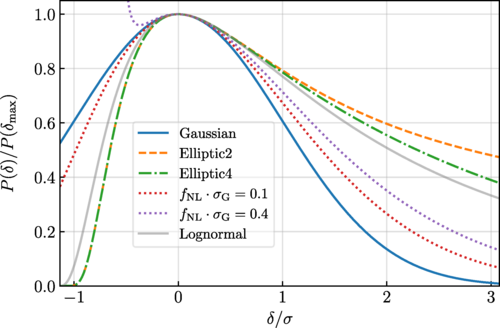Centro de Excelencia Severo Ochoa
Menú
Buscar

The question of how the great structures of the universe were formed - galaxies, clusters, black holes - is one of the oldest in cosmology. Since the 1980s, cosmologists have become aware of a key element in this process: quantum fluctuations.
According to the inflation model, these energy changes occurred at specific points in space-time that formed the lumps of matter in the universe. To explain the rapid expansion of the universe in its early moments, cosmic inflation is a very popular theory.
The large structures we see today in our universe, such as massive clusters with tens of thousands of galaxies, were thought to have formed much later, at least after the structures observed in the microwave radiation background, approximately 379,000 years after the Big Bang, were observed.
The new result, however, provides an explanation for the existence of very large, very old structures, dating back to 200 to 400 million years ago, that should not exist under the standard cosmological model.
The largest distant galaxy cluster ever observed by existing telescopes, El Gordo, was discovered in 2014. "El Gordo is a very massive object dating from 6.4 billion years after the Big Bang, which would have formed very soon, and whose existence cannot be explained with previous models," says Juan García-Bellido, co-author of the study and researcher at the IFT.
It is theoretically impossible for clusters of several tens of thousands of galaxies to form until much later in the universe. The discovery of such massive objects so soon was surprising. It was therefore necessary to find an explanation", says the physicist.
Several years ago, the study's authors –Jose María Ezquiaga from Niels Bohr Institute, Juan García-Bellido from IFT UAM/CSIC and Vicent Vennin from University of CNR Paris– realized quantum fluctuations during the inflation stage affected this acceleration dynamics.
Prior to the present study, it was believed that these quantum fluctuations formed a very concrete graph, known as a Gaussian bell. According to the researchers, by applying equations that allow us to look a little further, we actually obtain a non-Gaussian distribution, with a 'tail' region, as shown below.

This suggests that these fluctuations could collapse into large structures, galaxies, clusters, or even larger structures. With the previous hypothesis, where we had a Gaussian-type function, these structures would have taken much longer to form due to gravitational collapse", explains Juan Garcia-Bellido.
With a Gaussian-type function, these structures would take much longer to form, so structures as large and early as El Gordo could not be explained. However, the new result, which yields functions with this 'tail', explains the formation of large, very massive structures much earlier than gravitational collapse could explain.
A recent interview with Ingrid Fadelli for Phys.org explains how Ezquiaga and his colleagues explored the formation of primitive black holes in the early universe: " We discovered that quantum fluctuations dominate the dynamics of cosmic inflation, leading to non-Gaussian density fluctuations with exponential tails. Quantum diffusion facilitates the formation of large fluctuations, which collapse into large structures, such as a primordial black holes".
For this work, we realized that “the same mechanism that leads to the formation of primordial black holes, an improvement in the non-Gaussian tail in primordial perturbation distribution, will lead to the collapse of larger objects, such as dark matter halos, which will later house galaxies and groups of galaxies”, he says.
Researchers can explain recent observations from the James Webb Space Telescope, for example, using these exponential non-Gaussian tails.
James Webb has been making very interesting discoveries since its launch in early 2022, which are now explained by this new result. For instance, galaxies with very high redshifts. Observation of astronomical objects is dependent on their redshift. Generally, it refers to an increase in the wavelength of electromagnetic radiation received by a detector as compared to the wavelength of electromagnetic radiation emitted by the source.
"We now know that massive black holes were already possible very early, which helped to create the seeds of galaxies," says García-Bellido.
Additionally, this new result helps ease tensions between observations and our standard cosmological model by explaining the emergence of larger-than-expected objects early in the universe. In his explanation to Phys.org, Ezquiaga said: "For example, massive clusters like El Gordo may seem unnatural under standard assumptions, while quantum diffusion makes them so."
Using computational methods, the researchers calculated the function that modifies classical evolution. The Fokker-Planck equation, which takes into account quantum fluctuations, yields an elliptic and lognormal function, instead of a Gaussian one.
Among the new graphs, this one shows the highest probability of collapse for primordial black holes, early galaxies, and very massive objects like the El Gordo cluster.
It was necessary to consider non-linear information and to open our minds, says García-Bellido. By measuring the non-Gaussianities of large-scale structures in galaxy catalogs, we are finally beginning to understand the behavior of the universe on a large scale.
It is hoped that researchers will continue to supplement the standard cosmological model with observations from deep-sky telescopes, and that their formation may correspond to this dynamic of quantum fluctuations during inflation.
The study also enables Juan García-Bellido to comment on the history of science: "Decades ago, there was a long gap between the theory and its application". He explains that General Relativity, for example, could not be applied until the 1960s, or the Higgs particle discovered nearly half a century after being theorized. “I'm lucky to be working at a time when experimental observations and theoretical predictions can go hand in hand, for at least 20 years," he says.
More information: Jose María Ezquiaga et al, Massive Galaxy Clusters Like El Gordo Hint at Primordial Quantum Diffusion, Physical Review Letters (2023). DOI: 10.1103/PhysRevLett.130.121003 https://journals.aps.org/prl/abstract/10.1103/PhysRevLett.130.12100
Social media